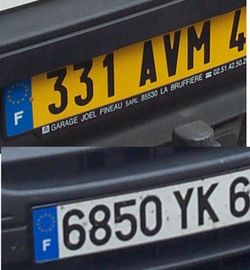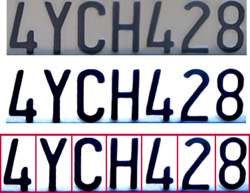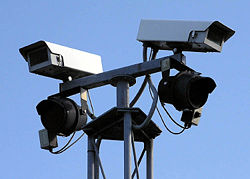Automatic number plate recognition
2008/9 Schools Wikipedia Selection. Related subjects: Road transport
Automatic number plate recognition (ANPR; see also other names below) is a mass surveillance method that uses optical character recognition on images to read the licence plates on vehicles. As of 2006, systems can scan number plates at around one per second on cars travelling up to 100 mph (160 km/h). They can use existing closed-circuit television or road-rule enforcement cameras, or ones specifically designed for the task. They are used by various police forces and as a method of electronic toll collection on pay-per-use roads, and monitoring traffic activity such as red light adherence in an intersection.
ANPR can be used to store the images captured by the cameras as well as the text from the licence plate, with some configurable to store a photograph of the driver. Systems commonly use infrared lighting to allow the camera to take the picture at any time of day. A powerful flash is included in at least one version of the intersection-monitoring cameras, serving to both illuminate the picture and make the offender aware of his or her mistake. ANPR technology tends to be region specific, owing to plate variation from place to place.
Concerns about these systems have centered on privacy fears of government tracking citizens' movements and media reports of misidentification and high error rates. However, as they have developed, the systems have become much more accurate and reliable.
Other names
ANPR is sometimes known by various other terms:
- Automatic licence plate recognition (ALPR)
- Automatic vehicle identification (AVI)
- Car plate recognition (CPR)
- Licence plate recognition (LPR)
- Lecture Automatique de Plaques d'Immatriculation (LAPI)
Development history
The ANPR was invented in 1976 at the Police Scientific Development Branch in the UK. Prototype systems were working by 1979 and contracts were let to produce industrial systems, first at EMI Electronics then at Computer Recognition Systems (CRS) in Wokingham, UK. Early trial systems were deployed on the A1 road and at the Dartford Tunnel. The first arrest due to a detected stolen car was made in 1981.
Components
The software aspect of the system runs on standard PC hardware and can be linked to other applications or databases. It first uses a series of image manipulation techniques to detect, normalise and enhance the image of the number plate, and finally optical character recognition (OCR) to extract the alphanumerics of the licence plate. ANPR/ALPR systems are generally deployed in one of two basic approaches; one allows for the entire process to be performed at the lane location in real-time, the other transmits all the images from many lanes to a remote computer location and performs the OCR process there at some later point in time. When done at the lane site, the information captured of the plate alphanumeric, date-time, lane identification, and any other information that is required is completed in somewhere around 250 milliseconds. This information, now small data packets, can easily be transmitted to some remote computer for further processing if necessary, or stored at the lane for later retrieval. In the other arrangement there are typically large numbers of PCs used in a server farm to handle high workloads, such as those found in the London congestion charge project. Often in such systems there is a requirement to forward images to the remote server and this can require larger bandwidth transmission media.
Technology
ANPR uses optical character recognition (OCR) on images taken by cameras. When Dutch vehicle registration plates switched to a different style in 2002 one of the changes made was to the font, introducing small gaps in some letters (such as P and R) to make them more distinct and therefore more legible to such systems. Some licence plate arrangements use variations in font sizes and positioning – ANPR systems must be able to cope with such differences in order to be truly effective. More complicated systems can cope with international variants, though many programs are individually tailored to each country.
The cameras used can include existing road-rule enforcement or closed-circuit television cameras as well as mobile units which are usually attached to vehicles. Some systems use infrared cameras to take a clearer image of the plates.
Algorithms
There are six primary algorithms that the software requires for identifying a licence plate:
- Plate localisation – responsible for finding and isolating the plate on the picture
- Plate orientation and sizing – compensates for the skew of the plate and adjusts the dimensions to the required size
- Normalisation – adjusts the brightness and contrast of the image
- Character segmentation – finds the individual characters on the plates
- Optical character recognition
- Syntactical/Geometrical analysis – check characters and positions against country specific rules
The complexity of each of these subsections of the program determines the accuracy of the system. During the third phase (normalisation) some systems use edge detection techniques to increase the picture difference between the letters and the plate backing. A median filter may also be used to reduce the visual "noise" on the image.
Difficulties
There are a number of possible difficulties that the software must be able to cope with. These include:
- Poor image resolution, usually because the plate is too far away but sometimes resulting from the use of a low-quality camera.
- Blurry images, particularly motion blur
- Poor lighting and low contrast due to overexposure, reflection or shadows
- An object obscuring (part of) the plate, quite often a tow bar, or dirt on the plate
- A different font, popular for vanity plates (some countries do not allow such plates, eliminating the problem)
- Circumvention techniques
- Lack of coordination between countries or states. Two cars from different countries or states can have the same number but different design of the plate.
While some of these problems can be corrected within the software it is primarily left to the hardware side of the system to work out solutions to these difficulties. Increasing the height of the camera may avoid problems with objects (such as other vehicles) obscuring the plate, but introduces and increases other problems such as the adjusting for the increased skew of the plate.
Many countries now use licence plates that are retroreflective. This returns the light back to the source and thus improves the contrast of the image. In some countries, the characters on the plate are not reflective, giving a high level of contrast with the reflective background in any lighting conditions. A camera that makes use of infrared imaging (with a normal colour filter over the lens and an infrared light-source next to it) benefits greatly from this as the infrared waves are reflected back from the plate. This is only possible on dedicated ANPR cameras, however, and so cameras used for other purposes must rely more heavily on the software capabilities. Further, when a full-colour image is required as well as use of the ANPR-retrieved details it is necessary to have one infrared-enabled camera and one normal (colour) camera working together.
To avoid blurring it is ideal to have the shutter speed of a dedicated camera set to 1/1000th of a second. Because the car is moving, slower shutter speeds could result in an image which is too blurred to read using the OCR software, especially if the camera is much higher up than the vehicle. In slow-moving traffic, or when the camera is at a lower level and the vehicle is at an angle approaching the camera, the shutter speed does not need to be so fast. Shutter speeds of 1/500th of a second can cope with traffic moving up to 40 mph (64 km/h) and 1/250th of a second up to 5 mph (8 km/h).
On some cars, towbars may obscure one or two characters of the licence plate. Bikes on bike racks can also obscure the number plate, though in some countries and jurisdictions, such as New South Wales, "bike plates" are supposed to be fitted.
Some small-scale systems allow for some errors in the licence plate. When used for giving specific vehicles access to a barriered area the decision may be made to have an acceptable error rate of one character. This is because the likelihood of an unauthorised car having such a similar licence plate is seen as quite small. However, this level of inaccuracy would not be acceptable in most applications of an ANPR system.
Circumvention techniques
Vehicle owners have used a variety of techniques in an attempt to evade ANPR systems and road-rule enforcement cameras in general. One method increases the reflective properties of the lettering and makes it more likely that the system will be unable to locate the plate or produce a high enough level of contrast to be able to read it. This is typically done by using a plate cover or a spray, though claims regarding the effectiveness of the latter are disputed. In most jurisdictions, the covers are illegal and covered under existing laws, while in most countries there is no law to disallow the use of the sprays.
For the 407 toll route in Ontario, Canada, police have caught several advanced techniques that some motorists have attempted. One driver had a setup that allowed him to lift a wire from the driver's seat that would show a different plate as he was cruising through the camera zones. Other users have attempted to smear their licence plate with dirt or utilise covers to mask the plate.
Novelty frames around Texas licence plates were made illegal on 1 September 2003 by Senate Bill 439 because they caused problems with ANPR devices. That law made it a Class C misdemeanor (punishable by a fine of up to US $200), or Class B (punishable by a fine of up to US $2,000 and 180 days in jail) if it can be proven that the owner did it to deliberately obscure their plates.
There are some custom car rear panels with an inset for the licence plate at an angle, which changes the alignment of characters relative to the reading grid. Since most U.S. states no longer require new plates each year, perhaps the easiest way to disable recognition is simply to allow the reflective paint on the plates to become degraded by age and therefore unreadable.
If an ANPR system cannot read the plate it can flag the image for attention, with the human operators looking to see if they are able to identify the alphanumerics. It is then possible to do lookups on a database using wildcard characters for any part of the plate obscured, and use car details (make and model, for example) to refine the search.
In order to avoid surveillance or penalty charges, there has been an upsurge in car cloning, particularly in London. This is usually achieved by copying registration plates from another car of a similar model and age. This can be difficult to detect, especially as cloners may change the registration plates and travel behaviour to hinder investigations.
Police enforcement
The UK has an extensive Automatic number plate recognition CCTV network. Effectively, the police and Security services track all car movements around the country and are able to track any car in close to real time. Vehicle movements are stored for 5 years in the National ANPR Data Centre to be analyzed for intelligence and to be used for evidence.
Glutton System in Northern Ireland
In 1997 a system of one hundred ANPR cameras, codenamed GLUTTON, was installed to feed into the automated British Military Intelligence Systems in Northern Ireland. Further cameras were also installed on the British mainland, including unspecified ports on the east and west coasts.
Average Speed cameras
Another use for ANPR in the UK is for speed cameras which work by tracking vehicles' travel time between two fixed points, and therefore calculate the average speed. These cameras are claimed to have an advantage over traditional speed cameras in maintaining steady legal speeds over extended distances, rather than encouraging heavy braking on approach to specific camera locations and subsequent acceleration back to illegal speeds. There is no evidence that average speed cameras actually reduce accident rates long term, with many motorists arguing that average speed check systems encourage bunching. In addition with the revelation that speeding tickets can potentially be avoided by changing lanes, an additional safety hazard has been created by drivers swapping lanes between gantries just in case they have been speeding.
The longest stretch of average speed cameras in the UK is found on the A77 road in Scotland, with 30 miles being monitored between Glasgow and Ayr.
Traffic control
Many cities and districts have developed traffic control systems to help monitor the movement and flow of vehicles around the road network. This had typically involved looking at historical data, estimates, observations and statistics such as:
- Car park usage
- Pedestrian crossing usage
- Number of vehicles along a road
- Areas of low and high congestion
- Frequency, location and cause of road works
CCTV cameras can be used to help traffic control centres by giving them live data, allowing for traffic management decisions to be made in real-time. By using ANPR on this footage it is possible to monitor the travel of individual vehicles, automatically providing information about the speed and flow of various routes. These details can highlight problem areas as and when they occur and helps the centre to make informed incident management decisions.
Some counties of the United Kingdom have worked with Siemens Traffic to develop traffic monitoring systems for their own control centres and for the public. Projects such as Hampshire County Council's ROMANSE provide an interactive and real-time web site showing details about traffic in the city. The site shows information about car parks, ongoing road works, special events and footage taken from CCTV cameras. ANPR systems can be used to provide average driving times along particular routes, giving drivers the ability to choose which one to take. ROMANSE also allows travellers to see the current situation using a mobile device with an Internet connection (such as WAP, GPRS or 3G), thus allowing them to be alerted to any problems that are ahead.
The UK company Trafficmaster has used ANPR since 1998 to estimate average traffic speeds on non-motorway roads without the results being skewed by local fluctuations caused by traffic lights and similar. The company now operates a network of over 4000 ANPR cameras, but claims that only the four most central digits are identified, and no numberplate data is retained. <
Electronic toll collection
Toll roads
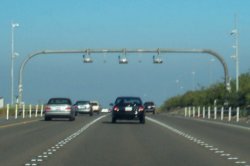
Ontario's 407 ETR highway uses a combination of ANPR and radio transponders to toll vehicles entering and exiting the road. Radio antennas are located at each junction and detect the transponders, logging the unique identity of each vehicle in much the same way as the ANPR system does. Without ANPR as a second system it would not be possible to monitor all the traffic. Drivers who opt to rent a transponder for C$2.35 per month are not charged the "Video Toll Charge" of C$3.55 for using the road, with heavy vehicles (those with a gross weight of over 5,000 kg) being required to use one. Using either system, users of the highway are notified of the usage charges by post.
There are numerous other electronic toll collection networks which use this combination of Radio frequency identification and ANPR. These include:
- Bridge Pass for the Saint John Harbour Bridge in Saint John New Brunswick
- CityLink in Melbourne, Australia
- FasTrak in California, United States
- Highway 6 in Israel
- Tunnels in Hong Kong
- Autopista Central in Santiago, Chile (site in Spanish)
- E-ZPass in New York, New Jersey, Massachusetts (as Fast Lane), and other States.
- Pike Pass in Oklahoma.
- OGS (Otomatik Geçiş Sistemi) used at Bosporus Bridges and Trans European Motorway entry points in İstanbul, Turkey.
- 121 in Texas.
Charge zones – the London congestion charge
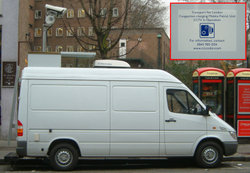
The London congestion charge is an example of a system that charges motorists entering a payment area. Transport for London (TfL) uses ANPR systems and charges motorists a daily fee of £8 paid before 10pm if they enter, leave or move around within the congestion charge zone between 7 a.m. and 6:30 p.m., Monday to Friday. Fines for travelling within the zone without paying the charge are £50 per infraction if paid before the deadline, doubling to £100 per infraction thereafter.
There are currently 1,500 cameras, which use Automatic Number Plate Recognition (ANPR) technology in use. There are also a number of mobile camera units which may be deployed anywhere in the zone.
It is estimated that around 98% of vehicles moving within the zone are caught on camera. The video streams are transmitted to a data centre located in central London where the ANPR software deduces the registration plate of the vehicle. A second data centre provides a backup location for image data.
Both front and back number plates are being captured, on vehicles going both in and out – this gives up to four chances to capture the number plates of a vehicle entering and exiting the zone. This list is then compared with a list of cars whose owners/operators have paid to enter the zone – those that have not paid are fined. The registered owner of such a vehicle is looked up in a database provided by the DVLA. A government investigation has found that a significant portion of the DVLA's database is incorrect. Furthermore, it is now the car owner's responsibility to report to the DVLA if they sell their car.
Up-to-date listing of systems & suppliers exist.
Stockholm congestion tax
In Stockholm, Sweden, ANPR is used for the congestion tax, owners of cars driving into or out of the inner city must pay a charge, depending on the time of the day.
Usage
Several companies and agencies using ANPR systems, such as Vehicle and Operator Services Agency (VOSA), Police Information Technology Organisation (PITO) and Transport for London.
Controversy
The introduction of ANPR systems has led to fears of misidentification and the furthering of 1984-style surveillance. In the United States, some such as Gregg Easterbrook oppose what they call "machines that issue speeding tickets and red-light tickets" as the beginning of a slippery slope towards an automated justice system:
- "A machine classifies a person as an offender, and you can't confront your accuser because there is no accuser... can it be wise to establish a principle that when a machine says you did something illegal, you are presumed guilty?"
Similar criticisms have been raised in other countries. Easterbrook also argues that this technology is employed to maximise revenue for the state, rather than to promote safety.
Older systems had been notably unreliable. This can lead to charges being made incorrectly with the vehicle owner having to pay £10 in order to be issued with proof (or not) of the offense. Improvements in technology have drastically decreased error rates, but false accusations are still frequent enough to be a problem.
Other concerns include the storage of information that could be used to identify people and store details about their driving habits and daily life, contravening the Data Protection Act along with similar legislation (see personally identifiable information). The laws in the UK are strict for any system that uses CCTV footage and can identify individuals.
Other uses
ANPR systems may also be used for/by:
- Section control, to measure average vehicle speed over longer distances.
- Border crossings
- Filling stations to log when a motorist drives away without paying for their fuel.
- Car parks or road entry systems to control access
- A marketing tool to log patterns of use
- Traffic management systems, which determine traffic flow using the time it takes vehicles to pass two ANPR sites
- - How ANPR can be used
- - Where ANPR can be used
- Drive Through Customer Recognition, to automatically recognize customers based on their license plate and offer them their last selection, improving service to the customer.
